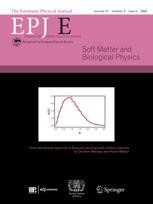Modelling the collective movement of bacteria
Research into the movement of packages of bacteria could help better understand the formation of troublesome biofilms.
New York | Heidelberg, 23 December 2022
 Biofilms form when microorganisms such as certain types of bacteria adhere to the surface of objects in a moist environment and begin to reproduce resulting in the excretion of a slimy glue-like substance.
Biofilms form when microorganisms such as certain types of bacteria adhere to the surface of objects in a moist environment and begin to reproduce resulting in the excretion of a slimy glue-like substance.
These biofilms aren’t just unpleasant and unappealing however, they can be seriously troublesome. For example, in the medical field, the formation of biofilm can reduce the effectiveness of antibiotic treatments. The key to understanding biomass formation lies in understanding how bacteria behave en masse.
A new paper in EPJ E by Heinrich-Heine-Universität, Düsseldorf, Germany, researcher Davide Breoni and his co-authors presents a mathematical model for the motion of bacteria that includes cell division and death, the basic ingredients of the cell cycle.
The team developed a mathematical model of bacterial movement in process creating a link between statistical physics and biophysics.
“Our new model belongs to a class of models for ‘active matter’ that currently encounter a lot of interest in statistical physics,” Breoni says. “This field studies the collective properties of particle systems that have their own energy source — bacteria are an exemplary case.”
The model devised by the team delivered a surprise by suggesting that when it comes to movement bacteria can act as a unit.
“In the course of our investigation, we found out that the model predicts that the formation of bacterial colonies can occur through the build-up of travelling waves, concentrated ‘packages’ of bacteria,” Breoni adds. “We did not expect this to arise from such a simple model as ours.”
He believes that the results should be interesting to the general public who may be aware of bacterial colonies, but not know how they move in a collective way.
Breoni concludes by pointing out this is a very simple model suggesting how the research could proceed from here. “We could try to make the model more realistic and confront the results to experiment to test its predictions,” he says. “On the other hand, this research is very much curiosity-driven and results from intense discussions among the researchers — an approach we’d like to maintain so we can continue to surprise ourselves with our findings.”
References: Breoni, D., Schwarzendahl, F.J., Blossey, R. et al. A one-dimensional three-state run-and-tumble model with a ‘cell cycle’. Eur. Phys. J. E 45, 83 (2022). https://doi.org/10.1140/epje/s10189-022-00238-7
Further Information
For more information visit: www.epj.org
Services for Journalists
The full-text article is available here.
Contact
Sabine Lehr | Springer | Physics Editorial Department
tel +49-6221-487-8336 | sabine.lehr@springer.com
